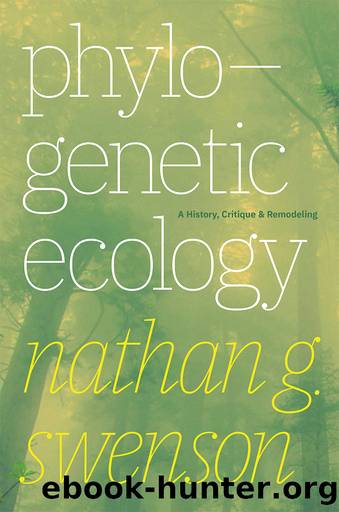Phylogenetic Ecology by Nathan G. Swenson

Author:Nathan G. Swenson [Swenson, Nathan G.]
Language: eng
Format: epub
Tags: SCI000000 Science / General
Publisher: University of Chicago Press
Published: 2019-11-20T00:00:00+00:00
5.2. Phylogenies as Backbones and Modifying the Canonical Framework for Community Assembly
A species pool may loosely be defined as the group of species that could potentially colonize a location. It is fairly easy to highlight the potential flaws in this definition, ranging from the ambiguity regarding the temporal scale on which colonization occurs (e.g., within a lifetime vs. during an interglacial cycle) to new pool members to the practical impossibility of knowing the ânormalâ dispersal abilities of all species, much less what degree of dispersal is possible during rare events (Lessard et al. 2012). Further, while ecologists have idealized approaches for how one should operationally define a species pool for their study, these approaches are frequently not possibleâparticularly for those not working with groups where geographic distributions may be available on many spatial scales (i.e., vertebrates). In reality, species pools are constructed from the list of the species in a small region or a meta-community. Such species pools almost assuredly do not include species that could potentially colonize the study location or communities being studied. Given the above, it may seem surprising that species pools are nearly essential conceptual and analytical tools for ecologists interested in studying community assembly. Assembly necessitates that species come from some source, and null modeling analyses that are foundational to studying community assembly require a species pool (Simberloff 1970; Colwell and Winkler 1984).
A stereotypical conceptual diagram for community assembly typically has a species pool that is sorted somehow into increasingly smaller groups of species, ultimately ending with the local assemblage of species (fig. 5.3; Weiher and Keddy 1995; Lambers et al. 1998; Weiher and Keddy 2001). Some have modified this flow diagram, somewhat, to include the possibility that local species interactions modify the abiotic environment or species interactions within regions, but these feedbacks do not make it back to the species pool scale (fig. 5.4; HilleRisLambers et al. 2012). Thus, the process of community assembly is conceptualized, purposefully or not, as a largely unidirectional phenomenon. For example, there are no inputs into the species pool itself, indicating that it is just a given entity. Is this to indicate that we do not care what processes explain the composition and diversity of the species pool itself? Do the lack of feedbacks between scales on the diagram indicate that we do not think contemporary ecological interactions will alter the future species composition at regional scales? I am sure that the vast majority of community ecologists would say we should be interested in the macroevolutionary processes influencing species pool composition and diversity and ecoevolutionary feedbacks. They may think such investigations are for evolutionary biologists to study, but this only highlights a disinterest in an integration of evolutionary history into community ecology. I would also argue that the diagram clearly outlines the priority placed by those studying community assembly on understanding species composition on very local scales as an endpoint and an unwarranted belief that differential macroevolutionary rates and their impact on species pool composition and diversity are not a major influence on community assembly.
Download
This site does not store any files on its server. We only index and link to content provided by other sites. Please contact the content providers to delete copyright contents if any and email us, we'll remove relevant links or contents immediately.
ASTROPHYSICS FOR NON-MATHEMATICIANS by Unknown(284)
A Brief Introduction to Classical Mechanics with Illustrative Problems (181 Pages) by Shahen Hacyan(284)
Physics in Minutes by Giles Sparrow(274)
Understandable Statistics. Concepts and Methods by Charles Henry Brase Corrinne Pellillo Brase Jason Dolor James Seibert(251)
Modern Physics by Gary N. Felder and Kenny M. Felder(249)
Calculus - Single and Multivariable 6th ed. by D. Hughes-Hallett(247)
Fundamentals of Physics I by R. Shankar;(237)
A History of Mathematical Impossibility by Lützen Jesper;(230)
Meat Less: The Next Food Revolution by David Julian McClements(228)
Iraq at the Crossroads by Toby Dodge(220)
Probabilistic Risk Analysis and Bayesian Decision Theory by Marcel van Oijen & Mark Brewer(218)
Principles of Modern Chemistry by David W. Oxtoby H.P. Gillis & Laurie J. Butler(217)
A Mathematician Comes of Age by Krantz Steven G(205)
The Parrot in the Mirror by Antone Martinho-Truswell(204)
Practical Math Success in 20 Minutes a Day by Mark A. McKibben(204)
Sensory Ecology, Behaviour, and Evolution by Stevens Martin;(200)
Calculus, Early Transcendentals, International Metric Eighth Edition by James Stewart(196)
Chemistry for the IB Diploma Third edition by Christopher Talbot Chris Davison(188)
Understanding the Universe: From Quarks to the Cosmos (591 pages) by Don Lincoln(188)
